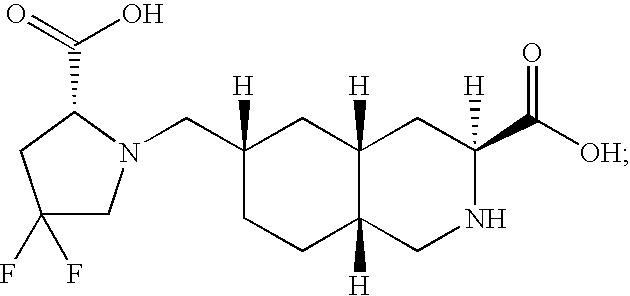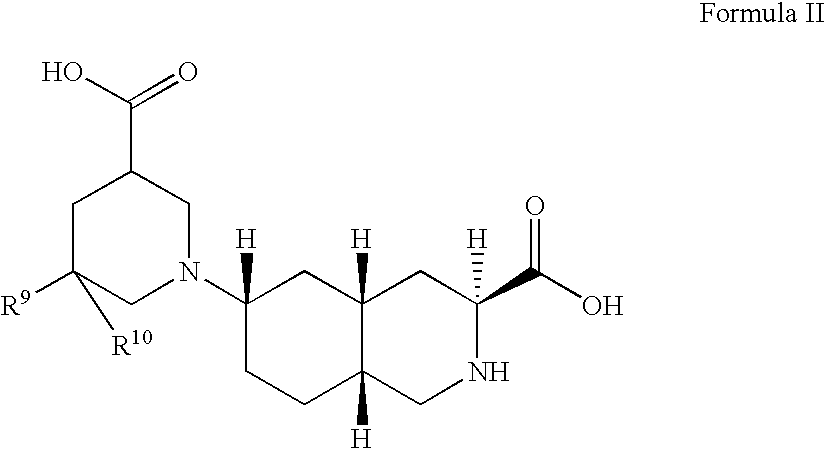Excitatory amino acid receptor antagonists
a technology of amino acid receptors and antagonists, which is applied in the direction of biocide, heterocyclic compound active ingredients, drug compositions, etc., can solve the problems of neuronal cell damage or loss, and achieve the effect of treating or preventing pain or migrain
- Summary
- Abstract
- Description
- Claims
- Application Information
AI Technical Summary
Benefits of technology
Problems solved by technology
Method used
Image
Examples
example 1
Preparation of 3S, 4aR, 6S, 8aR Ethyl 6-(((2S)-2-(Ethoxycarbonyl)-4,4 difluoropyrrolidinyl)methyl)-1,2,3,4,4a,5,6,7,8, 8a-decahydroisoquinoline-3-carboxylate
[0185]
A. Preparation of 3S, 4aR, 6S, 8aR Ethyl 6-((4-Methylphenyl)sulfonyloxy)methyl)-2-methoxycarbonyl-1,2,3,4,4a,5,6,7,8,8a-decahydroisoquinoline-3-carboxylate
[0186] To a solution of 15.0 g (50.1 mmol) of 3S, 4aR, 6S, 8aR ethyl 6-hydroxymethyl-2-methoxycarbonyl-decahydroisoquinoline-3-carboxylate (prepared by one of ordinary skill in the art following the procedures as disclosed in U.S. Pat. No. 5,670,516) cooled to 0° C. in CH2Cl2 (100 mL), was added triethylamine (20.9 mL, 150.3 mmol) followed by p-toluenesulfonyl chloride (19.1 g, 100.2 mmol) dissolved in CH2Cl2 (100 mL). The reaction was warmed to room temperature and stirred 16 h, then partitioned between CH2Cl2 and 10% aqueous NaHSO4. The aqueous layer was extracted with CH2Cl2 and the combined organics were dried over MgSO4, filtered, and concentrated in vacuo. Column...
example 2
Preparation of 3S, 4aR, 6S, 8aR 6-(((2S)-2-(Carboxylic acid)-4,4-difluoropyrrolidinyl)methyl)-1,2,3,4,4a,5,6,7,8,8a-decahydroisoquinoline-3-carboxylic Acid
[0202]
[0203] A solution of 3S, 4aR, 6S, 8aR ethyl 6-(((2S)-2-(ethoxycarbonyl)-4,4-difluoropyrrolidinyl)methyl)-2-methoxycarbonyl-1,2,3,4,4a,5,6,7,8,8a-decahydroisoquinoline-3-carboxylate (3.3 g, 7.10 mmol), the compound from Step D of Example 1 above, dissolved in 5 N aqueous HCl (15 mL), was heated at 90° C. for 18 h. The reaction mixture was cooled to room temperature and concentrated in vacuo. The resulting crude foam was dissolved in H2O (75 mL) and stirred in the presence of Dowex 50×8 (100-200) ion-exchange resin (10 g) for 2 h. The resin was filtered, washed sequentially with 1:1 THF / H2O and H2O, then stirred in the presence of 10% pyridine / H2O for 2 h. After filtration, the resin was washed with H2O, and the filtrate was concentrated in vacuo to provide the title compound (0.6 g, 97%) as a white foam:
[0204] MS(m / e): 347....
example 3
Preparation of 3S, 4aR, 6S, 8aR 6-(((2S)-2-(Carboxylic acid)-(4R)4-fluoropyrrolidinyl)methyl)-1,2,3,4,4a,5,6,7,8,8a-decahydroisoquinoline-3-carboxylic Acid
[0207]
A. Preparation of 3S, 4aR, 6S, 8aR Ethyl 6-(((2S)-2-(Ethoxycarbonyl)-(4R)4-fluoropyrrolidinyl)methyl)-2-methoxycarbonyl-1,2,3,4,4a,5,6,7,8,8a-decahydroisoquinoline-3-carboxylate
[0208] To a solution of 1.0 g (2.76 mmol) of 3S, 4aR, 6S, 8aR ethyl 6-bromomethyl-2-methoxycarbonyl-decahydroisoquinoline-3-carboxylate (prepared by one of ordinary skill in the art following the procedures as disclosed in U.S. Pat. No. 5,670,516) dissolved in CH3CN (2.5 mL) was added K2CO3 (0.57 g, 4.14 mmol), followed by trans-4-fluoro-L-proline ethyl ester (0.67 g, 4.14 mmol) (Demange, L.; Ménez, A.; Dugave, C. Tetrahedron Lett. 1998, 39, 1169-1172.). The reaction mixture was heated at 80° C. for 72 h, then cooled to room temperature and loaded onto a 10 g SCX Mega Bond Elut SPE cartridge (Varian Sample Preparation Products). The resin was washed...
PUM
| Property | Measurement | Unit |
|---|---|---|
| pH | aaaaa | aaaaa |
| temperature | aaaaa | aaaaa |
| temperature | aaaaa | aaaaa |
Abstract
Description
Claims
Application Information
 Login to View More
Login to View More - R&D
- Intellectual Property
- Life Sciences
- Materials
- Tech Scout
- Unparalleled Data Quality
- Higher Quality Content
- 60% Fewer Hallucinations
Browse by: Latest US Patents, China's latest patents, Technical Efficacy Thesaurus, Application Domain, Technology Topic, Popular Technical Reports.
© 2025 PatSnap. All rights reserved.Legal|Privacy policy|Modern Slavery Act Transparency Statement|Sitemap|About US| Contact US: help@patsnap.com



